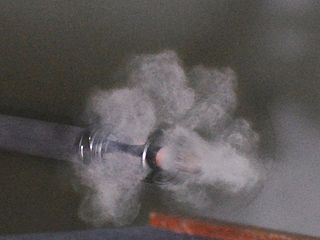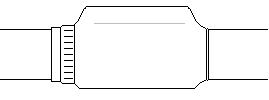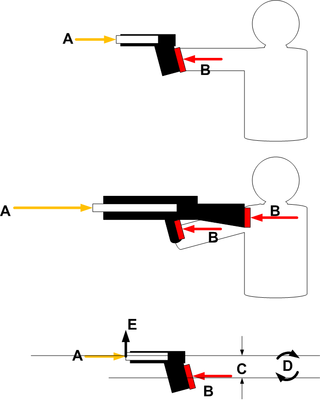
A muzzle brake or recoil compensator is a device connected to, or a feature integral to the construction of, the muzzle or barrel of a firearm or cannon that is intended to redirect a portion of propellant gases to counter recoil and unwanted muzzle rise. Barrels with an integral muzzle brake are often said to be ported.

Recoil is the rearward thrust generated when a gun is being discharged. In technical terms, the recoil is a result of conservation of momentum, as according to Newton's third law the force required to accelerate something will evoke an equal but opposite reactional force, which means the forward momentum gained by the projectile and exhaust gases (ejectae) will be mathematically balanced out by an equal and opposite momentum exerted back upon the gun.

A recoilless rifle (rifled), recoilless launcher (smoothbore), or simply recoilless gun, sometimes abbreviated to "RR" or "RCL" is a type of lightweight artillery system or man-portable launcher that is designed to eject some form of countermass such as propellant gas from the rear of the weapon at the moment of firing, creating forward thrust that counteracts most of the weapon's recoil. This allows for the elimination of much of the heavy and bulky recoil-counteracting equipment of a conventional cannon as well as a thinner-walled barrel, and thus the launch of a relatively large projectile from a platform that would not be capable of handling the weight or recoil of a conventional gun of the same size. Technically, only devices that use spin-stabilized projectiles fired from a rifled barrel are recoilless rifles, while smoothbore variants are recoilless guns. This distinction is often lost, and both are often called recoilless rifles.
Muzzle velocity is the speed of a projectile with respect to the muzzle at the moment it leaves the end of a gun's barrel. Firearm muzzle velocities range from approximately 120 m/s (390 ft/s) to 370 m/s (1,200 ft/s) in black powder muskets, to more than 1,200 m/s (3,900 ft/s) in modern rifles with high-velocity cartridges such as the .220 Swift and .204 Ruger, all the way to 1,700 m/s (5,600 ft/s) for tank guns firing kinetic energy penetrator ammunition. To simulate orbital debris impacts on spacecraft, NASA launches projectiles through light-gas guns at speeds up to 8,500 m/s (28,000 ft/s). FPS and MPH are the most common American measurements for bullets. Several factors, including the type of firearm, the cartridge, and the barrel length, determine the bullet's muzzle velocity.

A grenade launcher is a weapon that fires a specially designed, large-caliber projectile, often with an explosive, smoke, or gas warhead. Today, the term generally refers to a class of dedicated firearms firing unitary grenade cartridges. The most common type are man-portable, shoulder-fired weapons issued to individuals, although larger crew-served launchers are issued at higher levels of organization by military forces.

A flash suppressor, also known as a flash guard, flash eliminator, flash hider, or flash cone, is a muzzle device attached to the muzzle of a rifle that reduces its visible signature while firing by cooling or dispersing the burning gases that exit the muzzle, a phenomenon typical of carbine-length weapons. Its primary intent is to reduce the chances that the shooter will be blinded in low-light shooting conditions. Contrary to popular belief, it is only a minor secondary benefit if a flash suppressor reduces the intensity of the flash visible to the enemy.

A gun barrel is a crucial part of gun-type weapons such as small firearms, artillery pieces, and air guns. It is the straight shooting tube, usually made of rigid high-strength metal, through which a contained rapid expansion of high-pressure gas(es) is used to propel a projectile out of the front end (muzzle) at a high velocity. The hollow interior of the barrel is called the bore, and the diameter of the bore is called its caliber, usually measured in inches or millimetres.

A tank gun is the main armament of a tank. Modern tank guns are high-velocity, large-caliber artilleries capable of firing kinetic energy penetrators, high-explosive anti-tank, and cannon-launched guided projectiles. Anti-aircraft guns can also be mounted to tanks.
The CheyTac Intervention also known as the CheyTac M200, is an American bolt-action sniper rifle manufactured by CheyTac USA, which can also be classified as an anti-materiel rifle. It is fed by a seven-round detachable single-stack magazine. It is specifically chambered in either .408 Chey Tac or .375 Chey Tac ammunition. CheyTac Inc. states that the system is capable of delivering sub-MOA accuracy at ranges of up to 2,500 yd (2,286 m). It is based on the EDM Arms Windrunner.

Gun laying is the process of aiming an artillery piece or turret, such as a gun, howitzer, or mortar, on land, in air, or at sea, against surface or aerial targets. It may be laying for direct fire, where the gun is aimed similarly to a rifle, or indirect fire, where firing data is calculated and applied to the sights. The term includes automated aiming using, for example, radar-derived target data and computer-controlled guns.

A bore evacuator or fume extractor is a device which removes lingering gases and airborne residues from the barrel of an armored fighting vehicle's gun after firing, particularly in tanks and self-propelled guns. By creating a pressure differential in the barrel after the shell leaves, the bore evacuator causes most of the propellant gases and combustion residues to exit via the muzzle. Thus, when the breech opens for reloading, those gases and residues do not escape into the crew compartment and pose a hazard to the gun crew.
A muzzle booster or recoil booster is a device fixed to the muzzle of a firearm, intended to harness the energy of the escaping propellant to augment the force of recoil on portions of the firearm. In spite of its name, a muzzle booster does not increase muzzle force or velocity but instead is usually used to improve the reliability and/or rate of fire of a recoil operated firearm. It was invented by Hiram Maxim in 1894.

Armour-piercing fin-stabilized discarding sabot (APFSDS), long dart penetrator, or simply dart ammunition is a type of kinetic energy penetrator ammunition used to attack modern vehicle armour. As an armament for main battle tanks, it succeeds Armour-Piercing Discarding Sabot (APDS) ammunition, which is still used in small or medium caliber weapon systems.

The Royal Ordnance L11A5, officially designated Gun 120 mm Tk L11, is a 120 mm L/55 rifled tank gun design. It was the first of NATO's 120 mm main battle tank guns which became the standard calibre for Western tanks in the later period of the Cold War. A total of 3,012 of the L11 guns were produced by 2005. The list price was US$227,000 in 1990.

Muzzle rise, muzzle flip or muzzle climb refers to the tendency of a firearm's or airgun's muzzle to rise up after firing. It more specifically refers to the seemingly unpredictable "jump" of the firearm's muzzle, caused by combined recoil from multiple shots being fired in quick succession. It has an adverse effect on maintaining accuracy with using automatic weapons or rapid-firing semi-automatic firearms, as a moving muzzle can throw off the shooter's aim, causing subsequent shots to miss the intended target.

In artillery, caliber or calibre is the internal diameter of a gun barrel, or, by extension, a relative measure of the barrel length.

A silencer, also known as a sound suppressor, suppressor, or sound moderator, is a muzzle device that suppresses the blast created when a gun is discharged, thereby reducing the acoustic intensity of the muzzle report and jump, by modulating the speed and pressure of the propellant gas released from the muzzle. Like other muzzle devices, a silencer can be a detachable accessory mounted to the muzzle, or an integral part of the barrel.
A gun stabilizer is a device that facilitates aiming an artillery piece by compensating for the motion of the platform on which it is mounted. For naval applications see ship gun fire-control system. Moving land-based systems tend to require more specialized stabilization. Due to the need to fire while in motion, tanks in World War II made some use of stabilization, but it became commonplace in later decades during the Cold War.

The CN08 is a 120 mm 55-caliber smoothbore gun produced by Hyundai WIA. It is incorrectly known as the licensed production of the Rheinmetall Rh-120 L/55, but it was indigenously developed by the Agency for Defense Development and WIA from 2003 to 2008 for the XK2 development project started in 1995. The development was completed after the field test ended in September 2008.
Gun dynamics encompasses aspects of gun technology, such as recoil and impact. During the 1970s, the introduction of the United States Army Symposium on Gun Dynamics defined it as the study of internal ballistics that are unrelated to propellants and combustion. In particular, it is concerned with the interactive dynamics between the projectile, barrel, and mounting, and the effect that they have on the accuracy and consistency of the gun.















